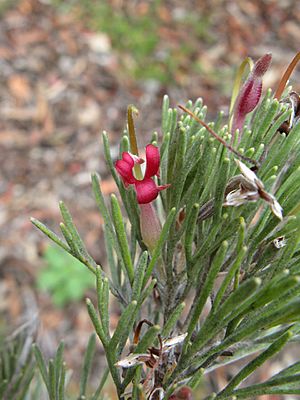Albany woollybush facts for kids
The Albany woollybush (scientific name: Adenanthos × cunninghamii) is a special type of plant. It's a hybrid shrub, which means it's a mix of two different parent plants. People also call it woollybush or prostrate woollybush. This plant belongs to the Proteaceae family. You can only find it growing naturally in the south-west part of Western Australia.
Quick facts for kids Albany woollybush |
|
|---|---|
 |
|
| Scientific classification | |
| Genus: |
Adenanthos
|
| Species: |
× cunninghamii
|
Contents
What it Looks Like
The Albany woollybush is a shrub that grows upright and spreads out. It can reach about 1.5 meters (5 feet) tall. When the branches are young, they have short, white hairs. As the plant gets older, these hairs fall off.
Its leaves are about 25 millimeters (1 inch) long. They are deeply split into three thin parts. Each of these parts usually splits again into two smaller, narrow sections called laciniae. So, most leaves have six laciniae, but some might have eight. Each lacinia is about 3 millimeters wide and slightly curved inward.
The plant has single red flowers. These flowers usually appear in September and October, and then again in March. The Albany woollybush looks a lot like another plant called Adenanthos sericeus. However, its leaf parts are flat, while A. sericeus has round, needle-like leaf parts.
Plant Family and Name
The Albany woollybush is a hybrid plant. This means it was created from two different parent plants. It was first described as a new species, Adenanthos cunninghamii, by a Swiss botanist named Carl Meissner. He published his description in 1845. The second part of its name, cunninghamii, honors a botanist named Allan Cunningham.
In 2003, scientists did a genetic study of Adenanthos cunninghamii. This study showed that it is indeed a hybrid. It is a mix of Adenanthos sericeus and Adenanthos cuneatus.
Where it Grows
You can find the Albany woollybush in the area around Torndirrup National Park. This includes Shire Reserve, which is south-west of Albany. It also grows in Two Peoples Bay Nature Reserve and Gull Rock, which are east of Albany.
This plant likes to grow in low woodlands, shrublands, and heathlands. It prefers sandy soils that are deep and drain water well.
Protecting the Plant
The Albany woollybush is listed as "Priority Four - Rare" by the Western Australian Department of Environment and Conservation. This means it's a rare plant that needs to be watched and protected.
It was once listed as "Endangered" under a law called the Environment Protection and Biodiversity Conservation Act 1999. But in 2006, it was removed from this list. This is because the law protects species, and since the Albany woollybush is a hybrid (a mix of two species), it didn't fit the definition of a single species under that law.
The plant can also get sick from a disease called Phytophthora cinnamomi dieback. This disease can cause plants to die.
Growing the Albany Woollybush
People often grow the Albany woollybush because of its beautiful, silvery leaves. Its flowers are not very showy, but they produce a lot of sweet nectar. This nectar attracts birds like honeyeaters.
Even though it comes from a place with dry summers, it can grow well in places with humid summers. It likes to be in full sun or partial shade. It also needs light soil that drains water easily. You can grow new plants fairly easily from cuttings taken from the plant's current year's growth.
See also
 In Spanish: Adenanthos × cunninghamii para niños
In Spanish: Adenanthos × cunninghamii para niños

